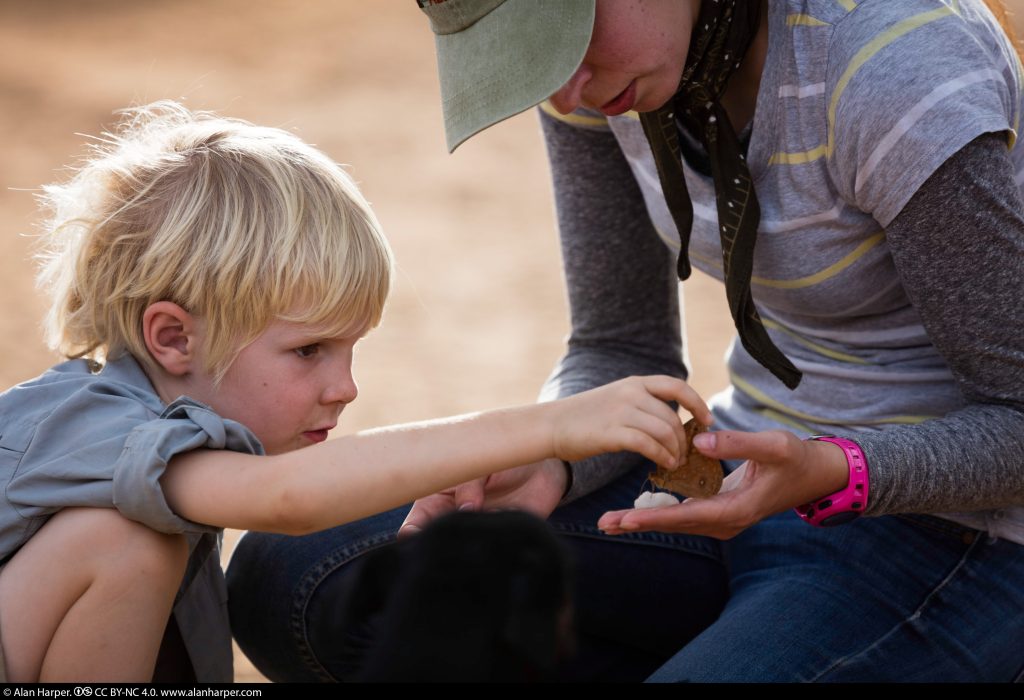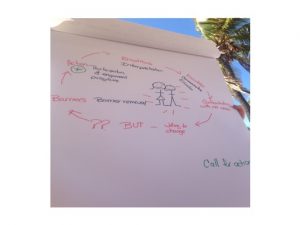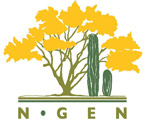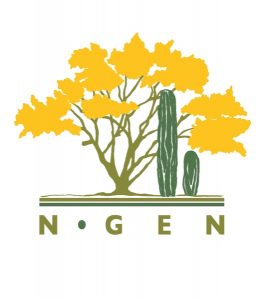
Title: Giving Conservation a Voice
Convenors: Trica Oshant Hawkins and Ana Luisa Figueroa
Participants: Horacio Cabrera, Mayra Estrella Astorga, Anny Peralta Garcìa, Jorge H- Valdez Villavicencio, Lara Cornejo Denman, Paloma Ponce González, Elisa Villalpando, Catherine Ramos García, Nestor Orona, Cinthia Tatiana Cornejo Gonzalez, Jose de Jesus Flores, Ben Wilder, Martha Campbell, Kelly Muller, Ednita Aispuro, Itzel Hernandez, Romelia Barnett, Kristhe Mattiam, Lani Hanna, Lorayne Meltzer, Ami Adams
Session theme:
This session focused on the value of interpretation and environmental education in conveying effectively important scientific and conservation messages to audiences beyond the scientific community.
Session discussion:
Discussion items included the importance of approaching environmental education from all levels, from formal (school-based) programs to non-formal methods; how invoking participants’ emotions in one’s education programs is far more powerful and memorable than simply conveying information; how effective environmental education is a cycle or continuum, moving learners (the audience or participants) from emotions and awareness, to knowledge, and ultimately to action. The importance of identifying the conservation “action” outcomes in advance of program development was discussed, both as a guide for development and as a means of evaluating program success.
Action Items:
- Create an environmental education network within N-Gen through which environmental educators can share contact information, program materials, ideas, etc.
- All EE programs should start with a process of planning to assure that the goals and objectives are linked to conservation goals or threat reduction goals, and that there is a clear objective of changes in behavior, attitude and knowledge. There has to be a clear call for action for each audience.
- The long term commitment is imperative, if it is not possible, start collaboration.
- Important to listen to the community before you plan and implement any education program.
- It is important that EE programs do not stop with awareness, but continue with a barrier removal program toward achieving changes of attitude or behavior (call of action). If you do not have that capacity. Start looking for partners.
- Adaptive Management is a must in the cycle of every EE program.
- It is also important to reach the sector of the society that is not connected to nature to promote awareness
Session Notes:
Trica started the discussion sharing her experience in the development of an environmental studies program: Juntos – Intercultural Environmental Studies in the Western Borderlands. This was about 15-17 years ago. Juntos was developed with and for educators and students in high schools on both sides of the border between Ambos Nogales and Yuma/San Luis Rio Colorado. A “cuaderno de trabajo” was published by the Secretary of Education and Culture for the state of Sonora. Some of the interesting aspects of the project included:
- Teachers were asked what they needed or wanted but they had no context to provide an answer – they had never been asked such a question and were only used to teaching the books handed to them.
- The program was embraced at a governmental level in Mexico but only on a local level in Arizona.
- After project development and dissemination, there was no funding to follow the results of the program nor whether or not it is still in use today.
Lorayne Meltzer shared the success story of Prescott College’s Kino Bay Field Marine Ecology Station. PC interns have been conducting EE programs in the local elementary schools for 15 years.
The strengths of that program are that the PC interns are in the schools every day, every year (value of permanence). The teacher turnover is somewhat high there but young presenters coming to the classrooms with EE programs everyday builds a sense of confidence in the students for the programs and what they are focusing on: the environment – Their environment.
In her experience when there are several programs complementing each other the impact is higher (example of Prescott and CONANP in Kino Bay)
The challenges of the program is the lack of ability to really evaluate the effectiveness of the program in the community – How does this education result in behavior / participation of the community and the region. Also how does this long term program compare with a program that lasts only two weeks but is rich in materials and activities?
Elisa Villalpando. Archaeologist, shared tht at the Cerro de Trincheras archaeological site, they have operated since 1991 an outreach program with the local community. The result is that the community recognizes the archaeological studies they perform and the kids from the community feel they belong to this site (appropriation). The key audience are teens from “secundaria”.
This has been a long term commitment with very positive results.
Mario has used “interpretation” (NAI) as a form of EE. He connects teens to nature as he promotes reading. His program (DE LA LECTURA A LA AVENTURA/FROM READING TO ADVENTURE) chooses specific books that the kids should read and then they take them to the field and experience there some selected situations or scenes from the book. The way to connect teens with nature is through a living experience. They evaluate the impact of the program through a selection of exit questions.
Mario has a key question: How to promote true collaboration among ngos and government?
Ana shares that for collaboration to work there are several elements:
- Clear strategy (where are we going), what are our goals and objectives?
- Clear collaboration framework: map of actors, their intangible values and interests, their mandates and missions.
- Invest time to develop trust and confidence with partner
- Process of conduction
- Developing an honest and respectful relationship
- We can make mistakes, we need to communicate, forgive and continue
Does EE lead to Conservation?
Ana shares about the evaluation of the EE program her office has operated for 15 years. What they learned is shared in this basic lessons learned.
Lesson 1. Many EE programs have excellent materials and actions but are not focused toward a clear conservation goal or a threat reduction goal. It is very important to run a good planning based on an environmental and sociocultural diagnosis to be sure we direct the program toward the priority threats and the conservation targets.
Lesson 2. Giving information without linking it to an emotion leads to a very limited result. If you think on a date of an important historical moment as the French revolution, or any other, probably you do not remember. Those were data that you learned. But if you are asked for the name of your first pet, or the first very emotive connection with nature, you will be able to respond easily. That is because the left side of your brain retains data, and the right side of you brain holds the emotions. Emotions are connected to long scale memory and it is hardly forgotten. Thus, if you really want to connect people to nature use emotions. If you want people to care about a conservation problem or a threat, use emotions and intangible values to connect them to their lives. For example…why do fishermen wives have to care about sargasum beds conservation? Because their conservation gives their husbands fish, thus, sustenance, and gives them security for their families.
Lesson 3. Awareness is not enough. Because once a person has confronted his/her of ideas with new ones after going through a learning process, they might want to change their attitudes of behavior, but probably they are not going to be able to do so, because of different barriers (educational, technological, cultural, economical). It is important that you design and implement a barrier removal program to assure that that pass from a wish to change to the possibility to do so. (SEE DIAGRAM)
Lesson 4. Change focus from communities to individuals. You can provide a community all the phases of this cycle but if a person does not complete it, the changes of attitude will not come. So we need to select a small group to live the whole cycle and then they will naturally attract others to this change. Generally they become role models to others in their community.
Ana’s cycle of conservation education:
The impact can be measured at each stage of the cycle but it sould leat to an indicator of threat reduction and an indicator of a conservation goal (long term)
Trica shared the North American Association of Environmental Education continuum of EE that expresses that EE moves people from awareness to action:
Awareness –Attitude – Knowledge – Skills – Action
The Emotional connection. A participant remarks that she barely remembers something taught in classes in which professors did not evoke emotions in their students. When the professor was liked however, and made an emotional connection, the subject was learned, information remembered.
Thus, it is very important that everybody that communicates science used emotions to connect people.
Lorayne comments that it is very important to listen – let the community lead. No only before planning but through the implementation of the programs.
Several members highlighted the importance to conduct EE programs under the principle of Adaptive management. When a program is not achieving its objectives, it is the moment to stop, rethink, review the assumptions and modify the programs.
Kathy comments on the importance of empowerment of communities, and shares examples of success in the Midriff Islands Region:
- Kids involved in the EE program of Prescott College left town to Study College, and then return to their community becoming example for others.
- Comunidad y Biodiversidad in collaboration with CONANP have a program of Commercial Fishermen from who were trained to conduct subaquatic monitoring of rocky reefs of the San Pedro Martir Islands Biosphere Reserve. From fishing fish to fishing data. There are now role models to many of their community.
Ana added two more examples.
- A group of fishermen and fishermen`s wives were trained in assertive communication, educational techniques, laws, how do MPAs work and the benefits of organization toward rights for use resources, and now run educational programs and social marketing campaigns for the San Pedro Martir Reserve, including now climate change.
- The “Para-ecologists” from the Con Caac territory. This young men have been trained in monitoring techniques, and the traditional knowledge of their people and now are monitoring different species in Tiburon Islands and the Cana del Infiernillo, as well as conducting conservation actions.
Adults are hard to educate, and there is a strong need connect with them through intangible values and interests, so it is suggested to start by defining your audiences, and the intangible values, interests and concerns of every audience divided by ages and gender. Then define for each of them the call for action, possible messages and type of communication or educational materials more fitted for the particular audience.
Horacio Comments that he had an EE program about trash and recycling, but without the barrier removal program and that was what he identifies as the factor limiting the complete success of this program, until he found a partner to move form awareness to action.
Ana invited everyone to create a “N-GEN EE network” to share materials, experiences, and alliances. It is a go.


